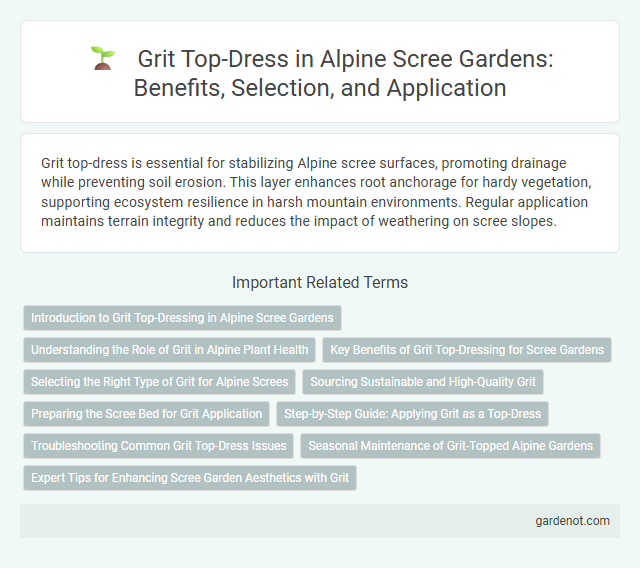Grit top-dress is essential for stabilizing Alpine scree surfaces, promoting drainage while preventing soil erosion. This layer enhances root anchorage for hardy vegetation, supporting ecosystem resilience in harsh mountain environments. Regular application maintains terrain integrity and reduces the impact of weathering on scree slopes.
Introduction to Grit Top-Dressing in Alpine Scree Gardens
Grit top-dressing in alpine scree gardens provides essential drainage and stability, mimicking natural mountainous conditions. This technique involves applying a layer of coarse, angular grit to the soil surface, promoting root health and preventing waterlogging crucial for alpine plant species. Effective grit top-dressing enhances soil aeration, reduces weed growth, and supports the delicate microhabitats required for specialized alpine flora.
Understanding the Role of Grit in Alpine Plant Health
Grit top-dress plays a crucial role in maintaining optimal soil drainage and aeration within alpine scree environments, essential for alpine plant health. Fine mineral particles improve root stability and prevent waterlogging, reducing the risk of root rot in sensitive alpine species. By mimicking natural scree conditions, grit enhances nutrient availability and supports the growth of drought-tolerant alpine flora.
Key Benefits of Grit Top-Dressing for Scree Gardens
Grit top-dressing enhances drainage and prevents soil compaction in Alpine scree gardens, crucial for plant health and root aeration. It stabilizes the soil surface, reducing erosion and weed growth while maintaining optimal moisture levels for drought-tolerant scree plants. This practice also improves the aesthetic appeal of scree gardens by providing a clean, uniform ground cover that mimics natural alpine environments.
Selecting the Right Type of Grit for Alpine Screes
Selecting the right type of grit for alpine screes involves choosing angular, coarse materials such as granite or quartz grit, which enhance drainage and prevent soil erosion on steep slopes. The grit size should range between 4 to 8 mm to promote stability while mimicking natural scree conditions. Using weather-resistant, mineral-based grit ensures long-lasting durability and supports native alpine flora by providing an optimal growing substrate.
Sourcing Sustainable and High-Quality Grit
Sourcing sustainable and high-quality grit for alpine scree involves selecting materials that are both environmentally responsible and durable under harsh mountain conditions. Ideal grit is typically derived from locally available, naturally weathered rocks or recycled materials that minimize ecological impact. Ensuring consistent grain size, hardness, and purity enhances stability and erosion control on alpine scree slopes, supporting long-term landscape preservation.
Preparing the Scree Bed for Grit Application
Preparing the scree bed for grit application involves removing loose debris and ensuring a stable, well-drained surface to promote effective grit adhesion. Proper leveling and compacting of the bed enhances the grit's ability to protect underlying alpine scree terrain from erosion and weathering. This preparation maximizes the longevity and protective qualities of the grit top-dress layer in alpine environments.
Step-by-Step Guide: Applying Grit as a Top-Dress
Applying grit as a top-dress on alpine scree improves drainage and stabilizes the rocky surface, essential for plant health in these harsh environments. Begin by cleaning the scree area to remove debris and loosen the soil slightly, then evenly spread a 1-2 cm layer of fine grit, ideally composed of crushed granite or quartz for optimal mineral balance. Finish by gently raking the grit to ensure good soil contact and prevent displacement, promoting moisture retention and root protection for alpine species.
Troubleshooting Common Grit Top-Dress Issues
Grit top-dress in alpine scree environments requires careful monitoring to prevent compaction and ensure proper drainage, which are essential for root health and stability. Common issues include uneven distribution, resulting in water pooling and root rot, and contamination by organic debris that can disrupt soil texture. Regular inspection and adjustment of grit layers enhance soil aeration and promote optimal alpine plant growth.
Seasonal Maintenance of Grit-Topped Alpine Gardens
Seasonal maintenance of grit-topped alpine gardens involves careful removal of debris and replenishment of grit to maintain optimal drainage and prevent compaction. Regular inspection during spring and autumn ensures the grit layer remains even, supporting root health and reducing weed growth. Applying fresh grit annually preserves the garden's aesthetic and promotes robust alpine plant growth in harsh mountain conditions.
Expert Tips for Enhancing Scree Garden Aesthetics with Grit
Applying grit top-dress in Alpine scree gardens enhances drainage and promotes root health for Alpine plants such as Saxifraga and Sempervivum. Experts recommend selecting angular grit sizes between 3-10 mm to prevent compaction and ensure stability on slopes. Regularly refreshing the grit layer maintains clean lines and enhances the natural rugged aesthetic characteristic of alpine scree environments.
Grit top-dress Infographic

 gardenot.com
gardenot.com